remove seats CITROEN DISPATCH SPACETOURER DAG 2018 Handbook (in English)
[x] Cancel search | Manufacturer: CITROEN, Model Year: 2018, Model line: DISPATCH SPACETOURER DAG, Model: CITROEN DISPATCH SPACETOURER DAG 2018Pages: 400, PDF Size: 16.99 MB
Page 11 of 400
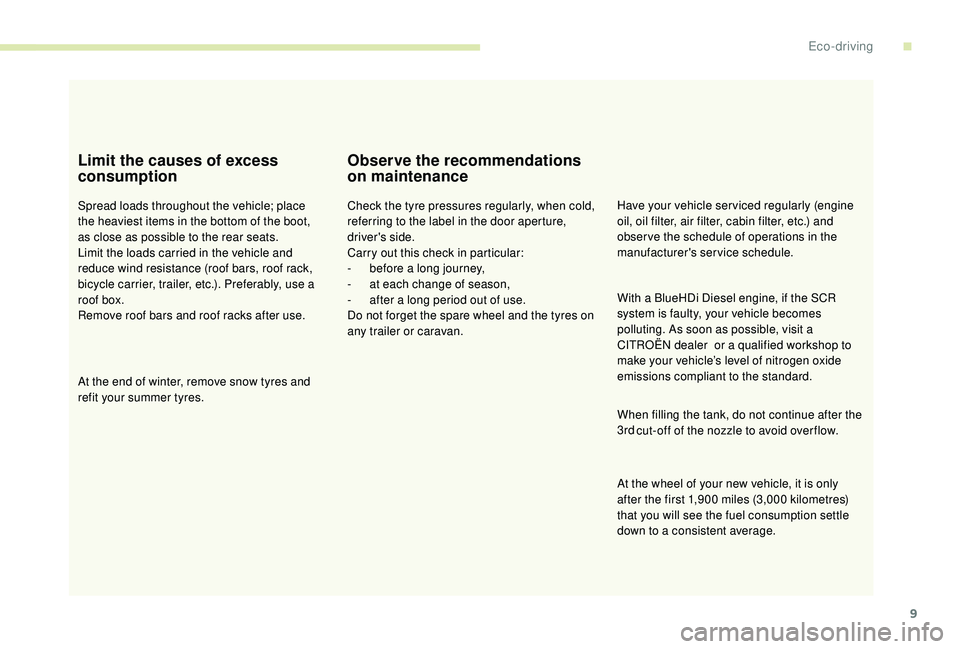
9
Limit the causes of excess
consumption
Spread loads throughout the vehicle; place
the heaviest items in the bottom of the boot,
as close as possible to the rear seats.
Limit the loads carried in the vehicle and
reduce wind resistance (roof bars, roof rack,
bicycle carrier, trailer, etc.). Preferably, use a
roof box.
Remove roof bars and roof racks after use.
At the end of winter, remove snow tyres and
refit your summer tyres.
Observe the recommendations
on maintenance
Check the tyre pressures regularly, when cold,
referring to the label in the door aperture,
driver's side.
Carry out this check in particular:
-
b
efore a long journey,
-
a
t each change of season,
-
a
fter a long period out of use.
Do not forget the spare wheel and the tyres on
any trailer or caravan. Have your vehicle ser viced regularly (engine
oil, oil filter, air filter, cabin filter, etc.) and
obser ve the schedule of operations in the
manufacturer's service schedule.
When filling the tank, do not continue after the
3rd
cut-off of the nozzle to avoid over flow.
At the wheel of your new vehicle, it is only
after the first 1,900
miles (3,000 kilometres)
that you will see the fuel consumption settle
down to a consistent average. With a BlueHDi Diesel engine, if the SCR
system is faulty, your vehicle becomes
polluting. As soon as possible, visit a
CITROËN dealer or a qualified workshop to
make your vehicle’s level of nitrogen oxide
emissions compliant to the standard.
.
Eco-driving
Page 84 of 400
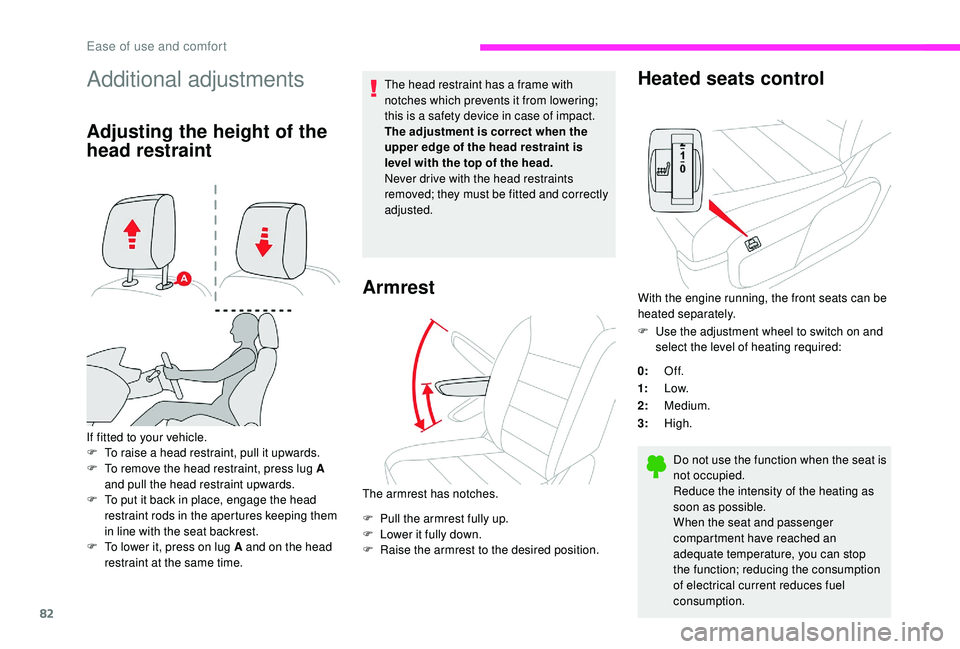
82
Additional adjustments
Adjusting the height of the
head restraint
If fitted to your vehicle.
F T o raise a head restraint, pull it upwards.
F
T
o remove the head restraint, press lug A
and pull the head restraint upwards.
F
T
o put it back in place, engage the head
restraint rods in the apertures keeping them
in line with the seat backrest.
F
T
o lower it, press on lug A and on the head
restraint at the same time. The head restraint has a frame with
notches which prevents it from lowering;
this is a safety device in case of impact.
The adjustment is correct when the
upper edge of the head restraint is
level with the top of the head.
Never drive with the head restraints
removed; they must be fitted and correctly
adjusted.
Armrest
The armrest has notches.
F
P
ull the armrest fully up.
F
L
ower it fully down.
F
R
aise the armrest to the desired position.
Heated seats control
With the engine running, the front seats can be
heated separately.
F
U
se the adjustment wheel to switch on and
select the level of heating required:
0: Of f.
1: Low.
2: Medium.
3: High.
Do not use the function when the seat is
not occupied.
Reduce the intensity of the heating as
soon as possible.
When the seat and passenger
compartment have reached an
adequate temperature, you can stop
the function; reducing the consumption
of electrical current reduces fuel
consumption.
Ease of use and comfort
Page 98 of 400
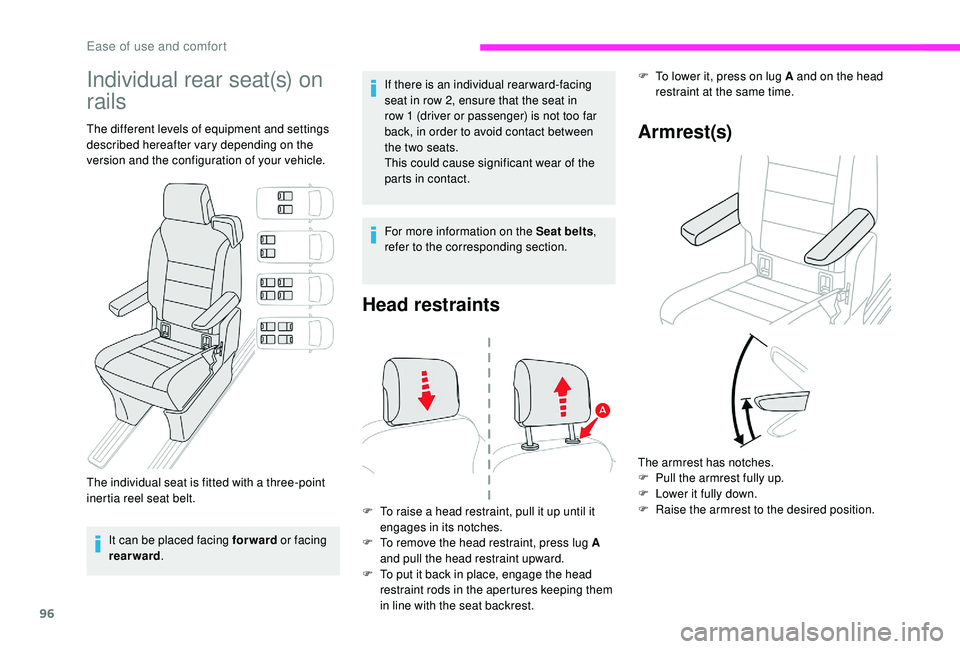
96
Individual rear seat(s) on
rails
The different levels of equipment and settings
described hereafter vary depending on the
version and the configuration of your vehicle.
The individual seat is fitted with a three-point
inertia reel seat belt.It can be placed facing forward or facing
rearward . If there is an individual rearward-facing
seat in row 2, ensure that the seat in
row 1
(driver or passenger) is not too far
back, in order to avoid contact between
the two seats.
This could cause significant wear of the
parts in contact.
For more information on the Seat belts ,
refer to the corresponding section.
Head restraints
F To raise a head restraint, pull it up until it engages in its notches.
F
T
o remove the head restraint, press lug A
and pull the head restraint upward.
F
T
o put it back in place, engage the head
restraint rods in the apertures keeping them
in line with the seat backrest.
Ar mrest(s)
F To lower it, press on lug A and on the head restraint at the same time.
The armrest has notches.
F
P
ull the armrest fully up.
F
L
ower it fully down.
F
R
aise the armrest to the desired position.
Ease of use and comfort
Page 100 of 400
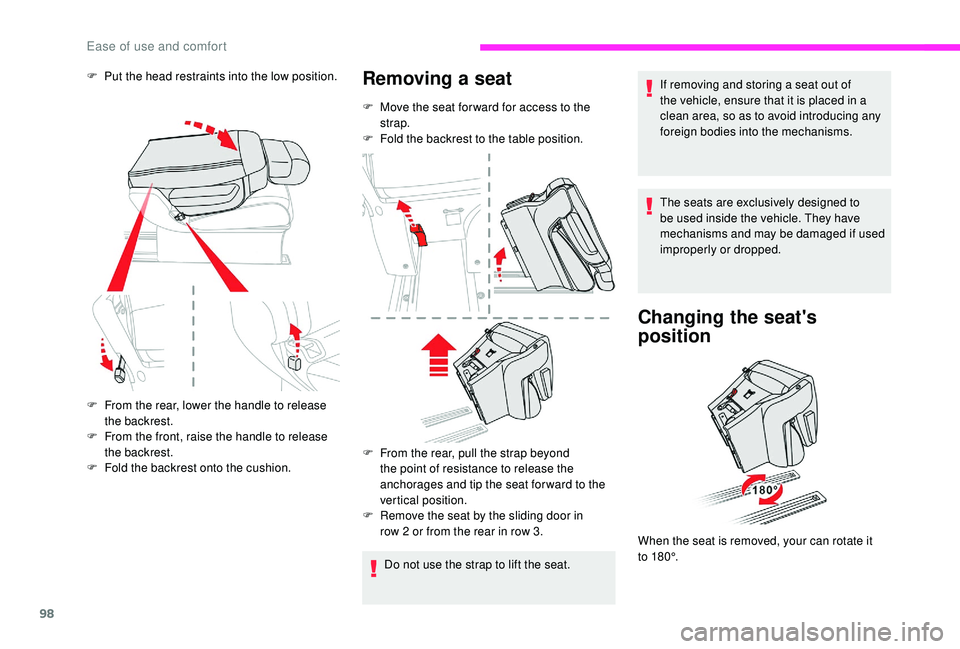
98
F From the rear, lower the handle to release the backrest.
F
F
rom the front, raise the handle to release
the backrest.
F
F
old the backrest onto the cushion.
Do not use the strap to lift the seat. If removing and storing a seat out of
the vehicle, ensure that it is placed in a
clean area, so as to avoid introducing any
foreign bodies into the mechanisms.
The seats are exclusively designed to
be used inside the vehicle. They have
mechanisms and may be damaged if used
improperly or dropped.
Changing the seat's
position
Removing a seat
F Move the seat for ward for access to the
strap.
F
F
old the backrest to the table position.
F
F
rom the rear, pull the strap beyond
the point of resistance to release the
anchorages and tip the seat for ward to the
vertical position.
F
R
emove the seat by the sliding door in
row 2
or from the rear in row 3. When the seat is removed, your can rotate it
t o 18 0 °.
F
P
ut the head restraints into the low position.
Ease of use and comfort
Page 102 of 400
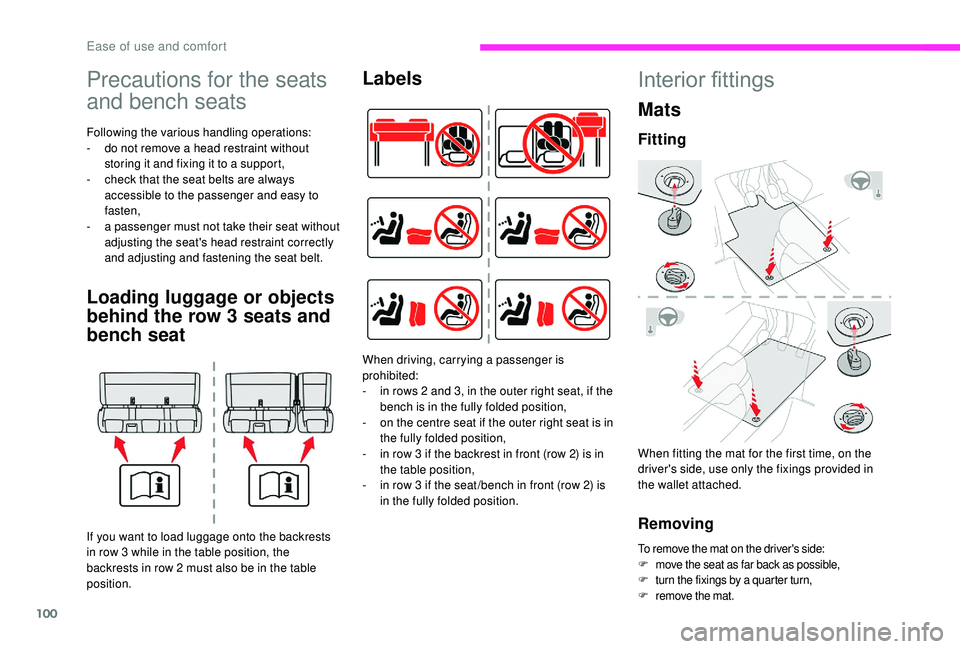
100
Precautions for the seats
and bench seats
Following the various handling operations:
- d o not remove a head restraint without
storing it and fixing it to a support,
-
c
heck that the seat belts are always
accessible to the passenger and easy to
fasten,
-
a p
assenger must not take their seat without
adjusting the seat's head restraint correctly
and adjusting and fastening the seat belt.
Loading luggage or objects
behind the row 3 seats and
bench seat
If you want to load luggage onto the backrests
in row 3
while in the table position, the
backrests in row 2
must also be in the table
position.
LabelsInterior fittings
Mats
Fitting
When fitting the mat for the first time, on the
driver's side, use only the fixings provided in
the wallet attached.
Removing
To remove the mat on the driver's side:
F m ove the seat as far back as possible,
F
t
urn the fixings by a quarter turn,
F
r
emove the mat.
When driving, carrying a passenger is
prohibited:
-
i
n rows 2 and 3, in the outer right seat, if the
bench is in the fully folded position,
-
o
n the centre seat if the outer right seat is in
the fully folded position,
-
i
n row 3 if the backrest in front (row 2) is in
the table position,
-
i
n row 3 if the seat /bench in front (row 2) is
in the fully folded position.
Ease of use and comfort
Page 108 of 400
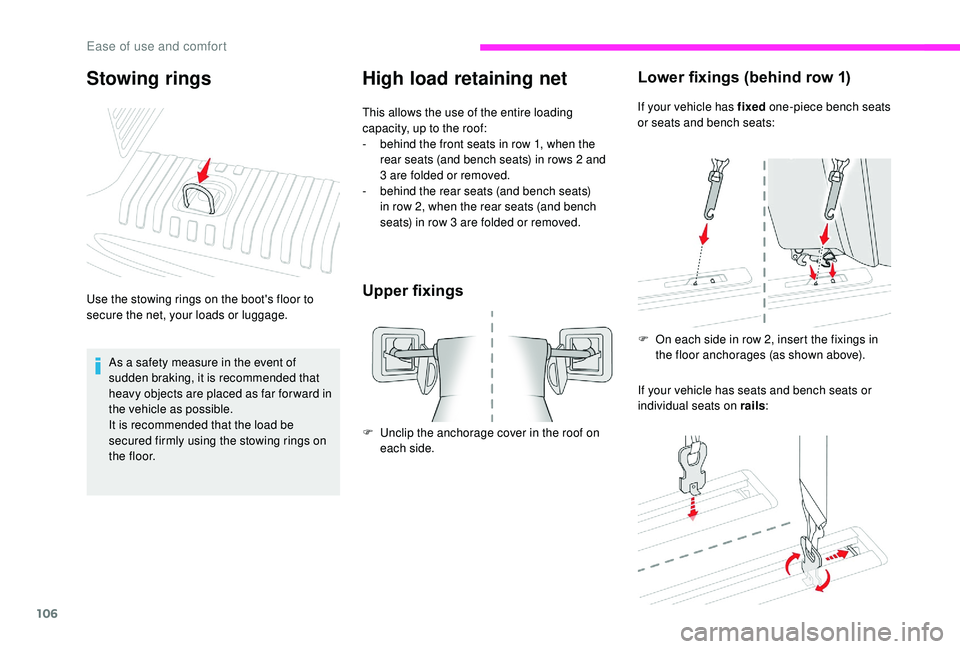
106
High load retaining net
This allows the use of the entire loading
capacity, up to the roof:
-
b
ehind the front seats in row 1, when the
rear seats (and bench seats) in rows 2
and
3
are folded or removed.
-
b
ehind the rear seats (and bench seats)
in row 2, when the rear seats (and bench
seats) in row 3
are folded or removed.
Upper fixings
F Unclip the anchorage cover in the roof on each side.
Lower fixings (behind row 1)
If your vehicle has fixed one-piece bench seats
or seats and bench seats:
If your vehicle has seats and bench seats or
individual seats on rails :
F
O
n each side in row 2, insert the fixings in
the floor anchorages (as shown above).
Stowing rings
Use the stowing rings on the boot's floor to
secure the net, your loads or luggage.
As a safety measure in the event of
sudden braking, it is recommended that
heavy objects are placed as far for ward in
the vehicle as possible.
It is recommended that the load be
secured firmly using the stowing rings on
t h e f l o o r.
Ease of use and comfort
Page 109 of 400
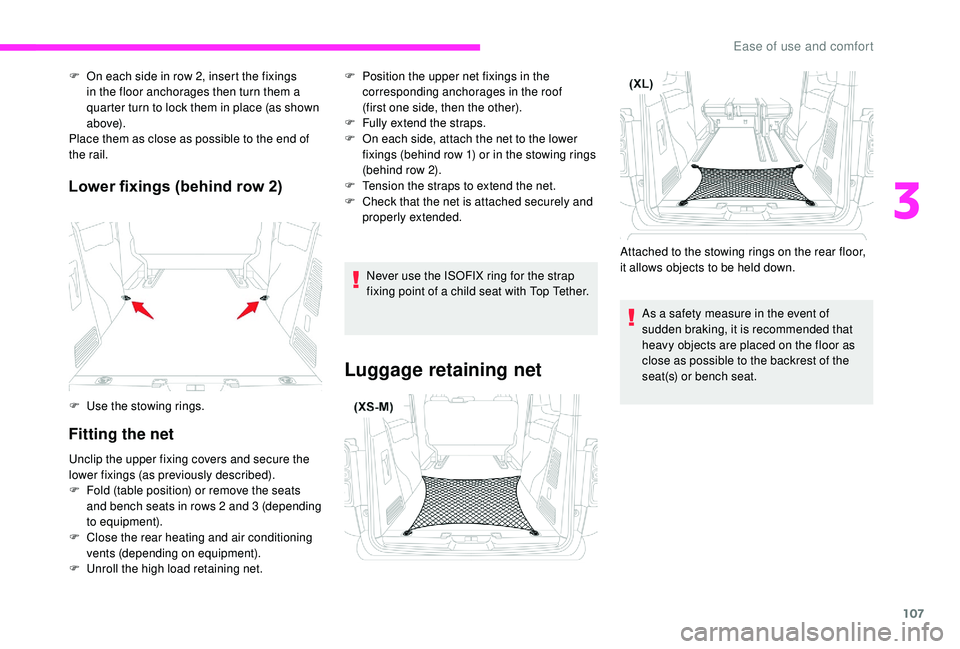
107
Lower fixings (behind row 2)
Fitting the net
F On each side in row 2, insert the fixings in the floor anchorages then turn them a
quarter turn to lock them in place (as shown
a b ove).
Place them as close as possible to the end of
the rail.
F
U
se the stowing rings.
Unclip the upper fixing covers and secure the
lower fixings (as previously described).
F
F
old (table position) or remove the seats
and bench seats in rows 2
and 3 (depending
to equipment).
F
C
lose the rear heating and air conditioning
vents (depending on equipment).
F
U
nroll the high load retaining net. F
P osition the upper net fixings in the
corresponding anchorages in the roof
(first one side, then the other).
F
F
ully extend the straps.
F
O
n each side, attach the net to the lower
fixings (behind row 1) or in the stowing rings
(behind row 2).
F
T
ension the straps to extend the net.
F
C
heck that the net is attached securely and
properly extended.
Never use the ISOFIX ring for the strap
fixing point of a child seat with Top Tether.
Luggage retaining net
Attached to the stowing rings on the rear floor,
it allows objects to be held down. As a safety measure in the event of
sudden braking, it is recommended that
heavy objects are placed on the floor as
close as possible to the backrest of the
seat(s) or bench seat.
3
Ease of use and comfort
Page 156 of 400
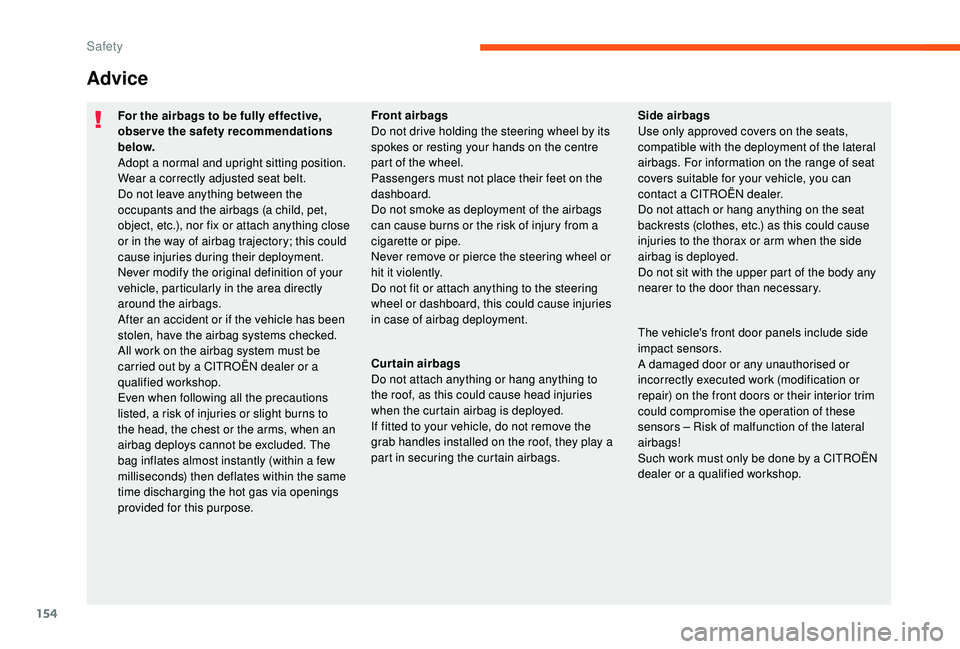
154
Advice
For the airbags to be fully effective,
observe the safety recommendations
below.
Adopt a normal and upright sitting position.
Wear a correctly adjusted seat belt.
Do not leave anything between the
occupants and the airbags (a child, pet,
object, etc.), nor fix or attach anything close
or in the way of airbag trajectory; this could
cause injuries during their deployment.
Never modify the original definition of your
vehicle, particularly in the area directly
around the airbags.
After an accident or if the vehicle has been
stolen, have the airbag systems checked.
All work on the airbag system must be
carried out by a CITROËN dealer or a
qualified workshop.
Even when following all the precautions
listed, a risk of injuries or slight burns to
the head, the chest or the arms, when an
airbag deploys cannot be excluded. The
bag inflates almost instantly (within a few
milliseconds) then deflates within the same
time discharging the hot gas via openings
provided for this purpose.Front airbags
Do not drive holding the steering wheel by its
spokes or resting your hands on the centre
part of the wheel.
Passengers must not place their feet on the
dashboard.
Do not smoke as deployment of the airbags
can cause burns or the risk of injury from a
cigarette or pipe.
Never remove or pierce the steering wheel or
hit it violently.
Do not fit or attach anything to the steering
wheel or dashboard, this could cause injuries
in case of airbag deployment.
Side airbags
Use only approved covers on the seats,
compatible with the deployment of the lateral
airbags. For information on the range of seat
covers suitable for your vehicle, you can
contact a CITROËN dealer.
Do not attach or hang anything on the seat
backrests (clothes, etc.) as this could cause
injuries to the thorax or arm when the side
airbag is deployed.
Do not sit with the upper part of the body any
nearer to the door than necessary.
Curtain airbags
Do not attach anything or hang anything to
the roof, as this could cause head injuries
when the curtain airbag is deployed.
If fitted to your vehicle, do not remove the
grab handles installed on the roof, they play a
part in securing the curtain airbags. The vehicle's front door panels include side
impact sensors.
A damaged door or any unauthorised or
incorrectly executed work (modification or
repair) on the front doors or their interior trim
could compromise the operation of these
sensors – Risk of malfunction of the lateral
airbags!
Such work must only be done by a CITROËN
dealer or a qualified workshop.
Safety
Page 167 of 400
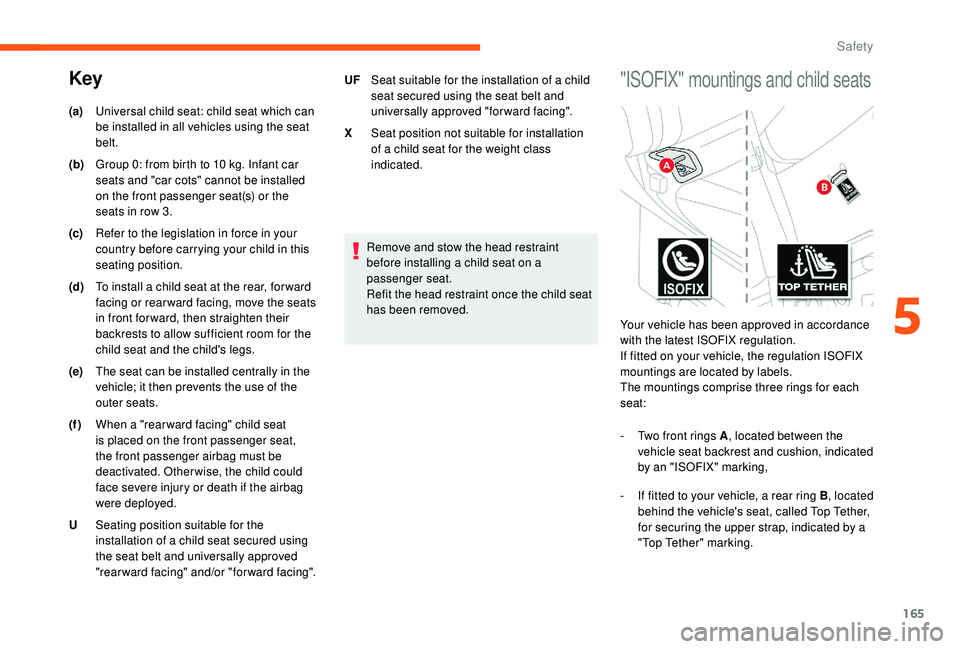
165
Remove and stow the head restraint
before installing a child seat on a
passenger seat.
Refit the head restraint once the child seat
has been removed.
(a)
Universal child seat: child seat which can
be installed in all vehicles using the seat
belt.
(b) Group 0: from birth to 10
kg. Infant car
seats and "car cots" cannot be installed
on the front passenger seat(s) or the
seats in row 3.
(c) Refer to the legislation in force in your
country before carrying your child in this
seating position.
(d) To install a child seat at the rear, for ward
facing or rear ward facing, move the seats
in front for ward, then straighten their
backrests to allow sufficient room for the
child seat and the child's legs.
(e) The seat can be installed centrally in the
vehicle; it then prevents the use of the
outer seats.
(f ) When a "rear ward facing" child seat
is placed on the front passenger seat,
the front passenger airbag must be
deactivated. Otherwise, the child could
face severe injury or death if the airbag
were deployed.
U Seating position suitable for the
installation of a child seat secured using
the seat belt and universally approved
"rearward facing" and/or "forward facing". UF
Seat suitable for the installation of a child
seat secured using the seat belt and
universally approved "forward facing".
X Seat position not suitable for installation
of a child seat for the weight class
indicated.
Key"ISOFIX" mountings and child seats
Your vehicle has been approved in accordance
with the latest ISOFIX regulation.
If fitted on your vehicle, the regulation ISOFIX
mountings are located by labels.
The mountings comprise three rings for each
seat:
-
T
wo front rings A , located between the
vehicle seat backrest and cushion, indicated
by an "ISOFIX" marking,
-
I
f fitted to your vehicle, a rear ring B , located
behind the vehicle's seat, called Top Tether,
for securing the upper strap, indicated by a
"Top Tether" marking.
5
Safety
Page 168 of 400
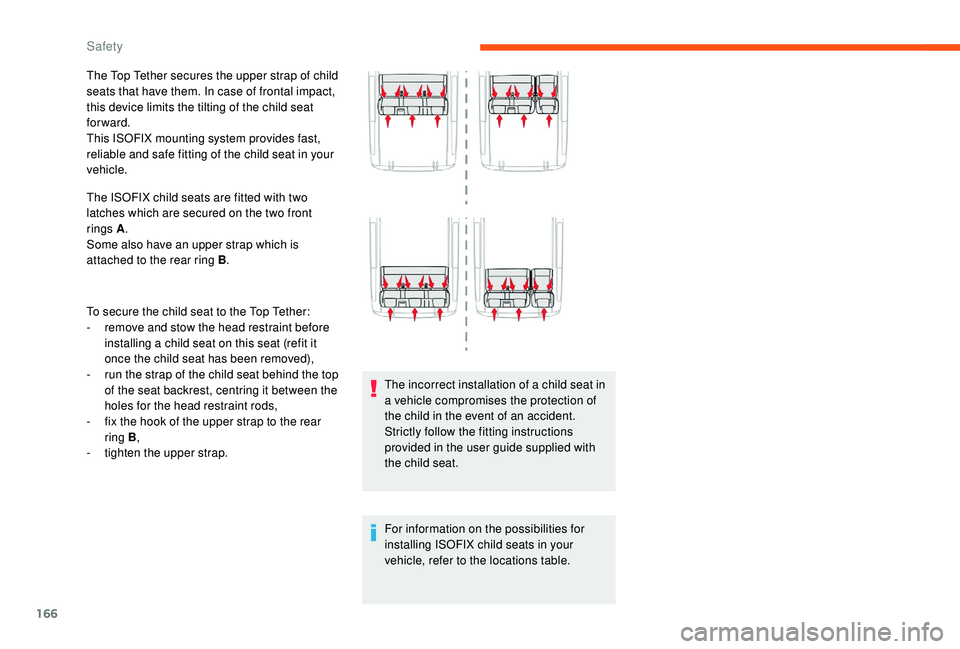
166
The Top Tether secures the upper strap of child
seats that have them. In case of frontal impact,
this device limits the tilting of the child seat
forward.
This ISOFIX mounting system provides fast,
reliable and safe fitting of the child seat in your
vehicle.The incorrect installation of a child seat in
a vehicle compromises the protection of
the child in the event of an accident.
Strictly follow the fitting instructions
provided in the user guide supplied with
the child seat.
For information on the possibilities for
installing ISOFIX child seats in your
vehicle, refer to the locations table.
The ISOFIX child seats are fitted with two
latches which are secured on the two front
rings A
.
Some also have an upper strap which is
attached to the rear ring B .
To secure the child seat to the Top Tether:
-
r
emove and stow the head restraint before
installing a child seat on this seat (refit it
once the child seat has been removed),
-
r
un the strap of the child seat behind the top
of the seat backrest, centring it between the
holes for the head restraint rods,
-
f
ix the hook of the upper strap to the rear
ring B ,
-
t
ighten the upper strap.
Safety